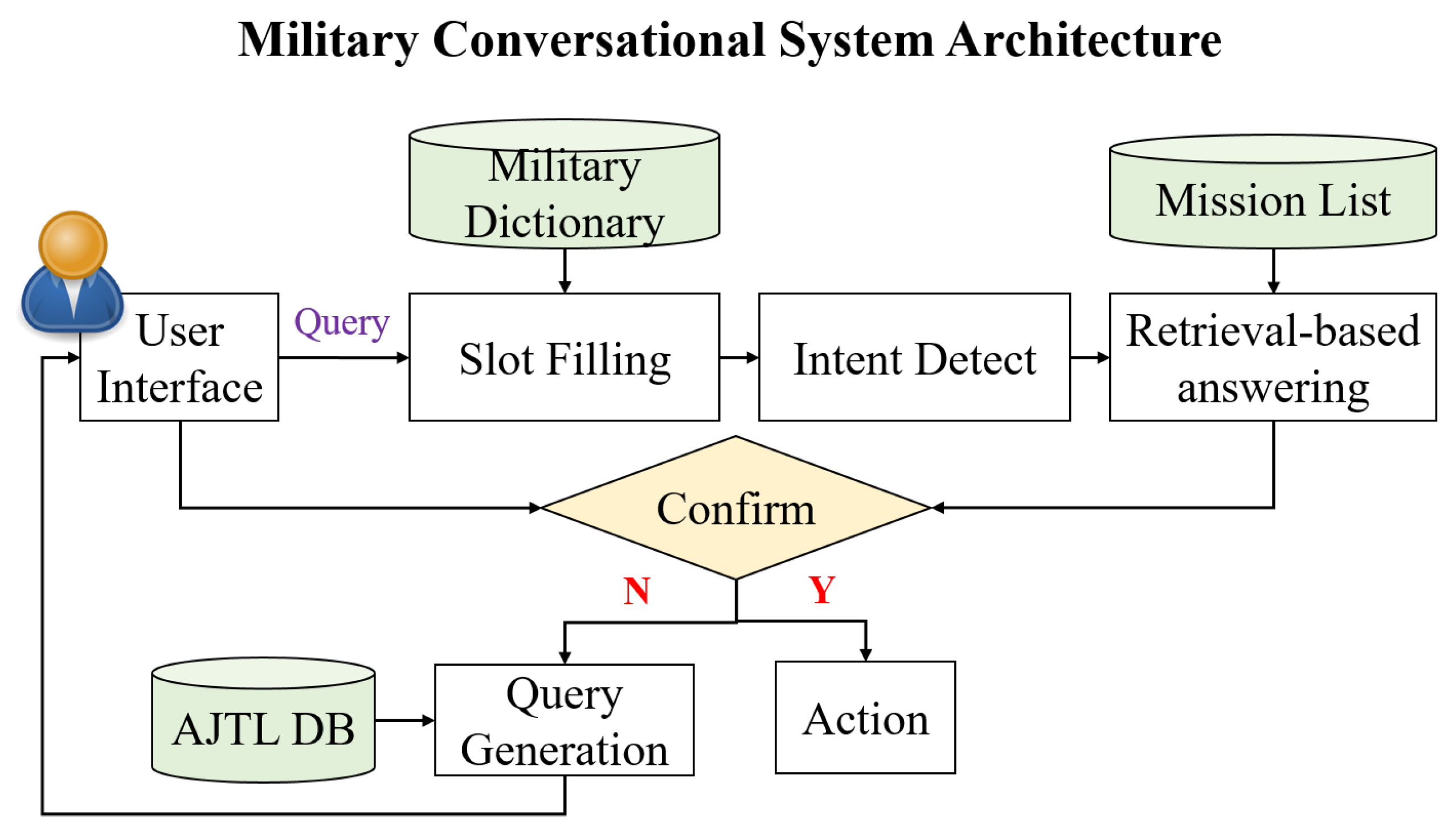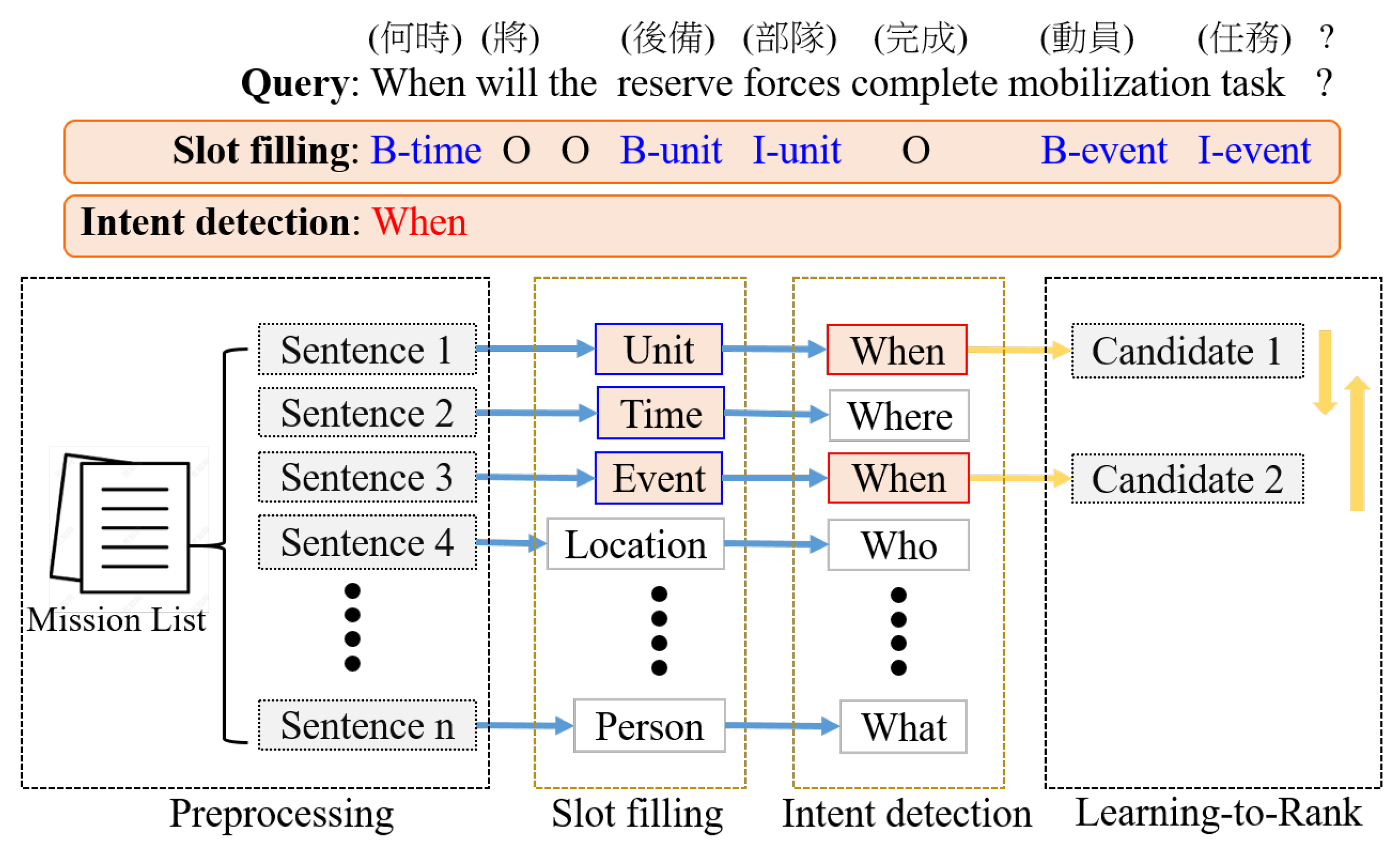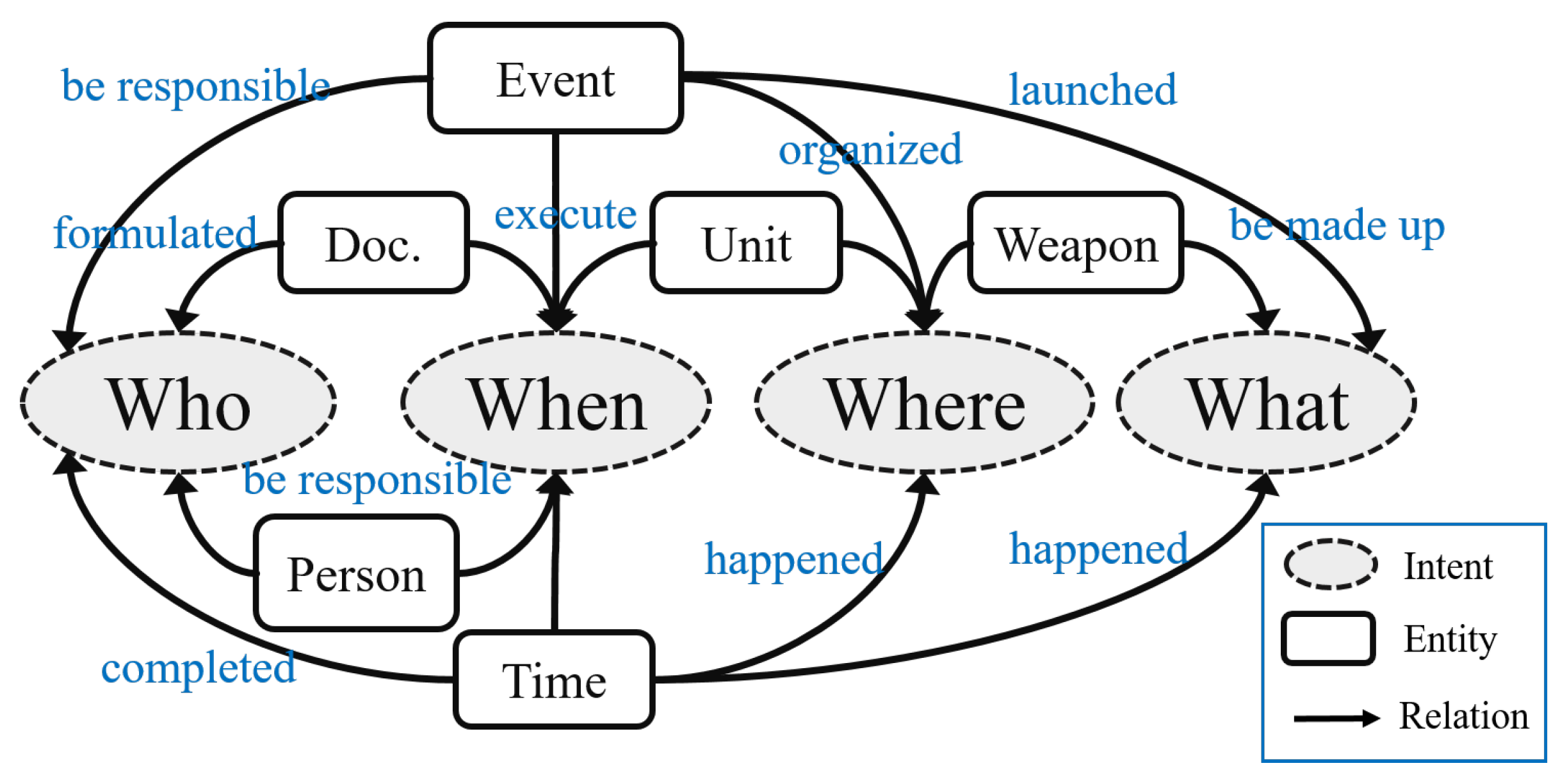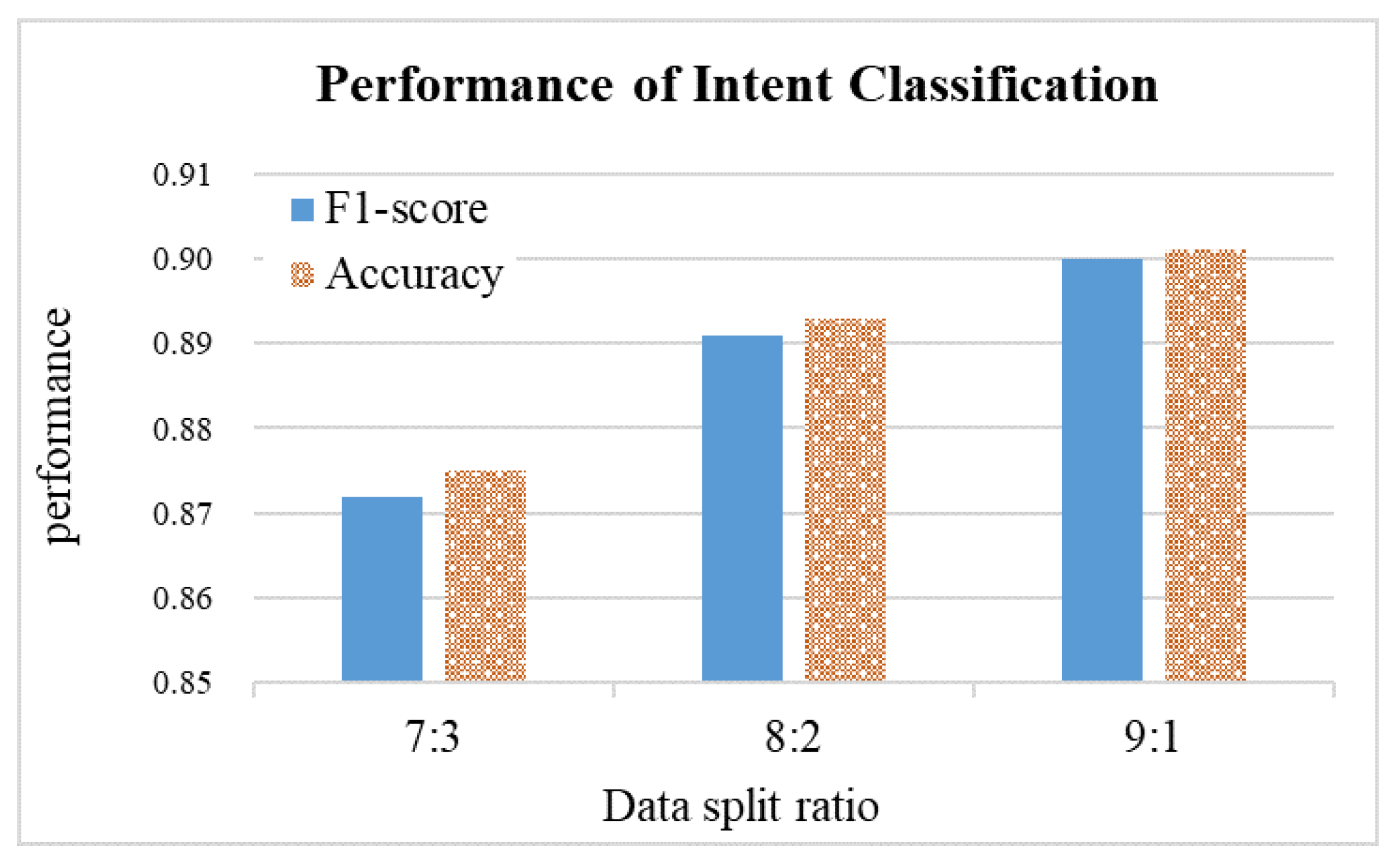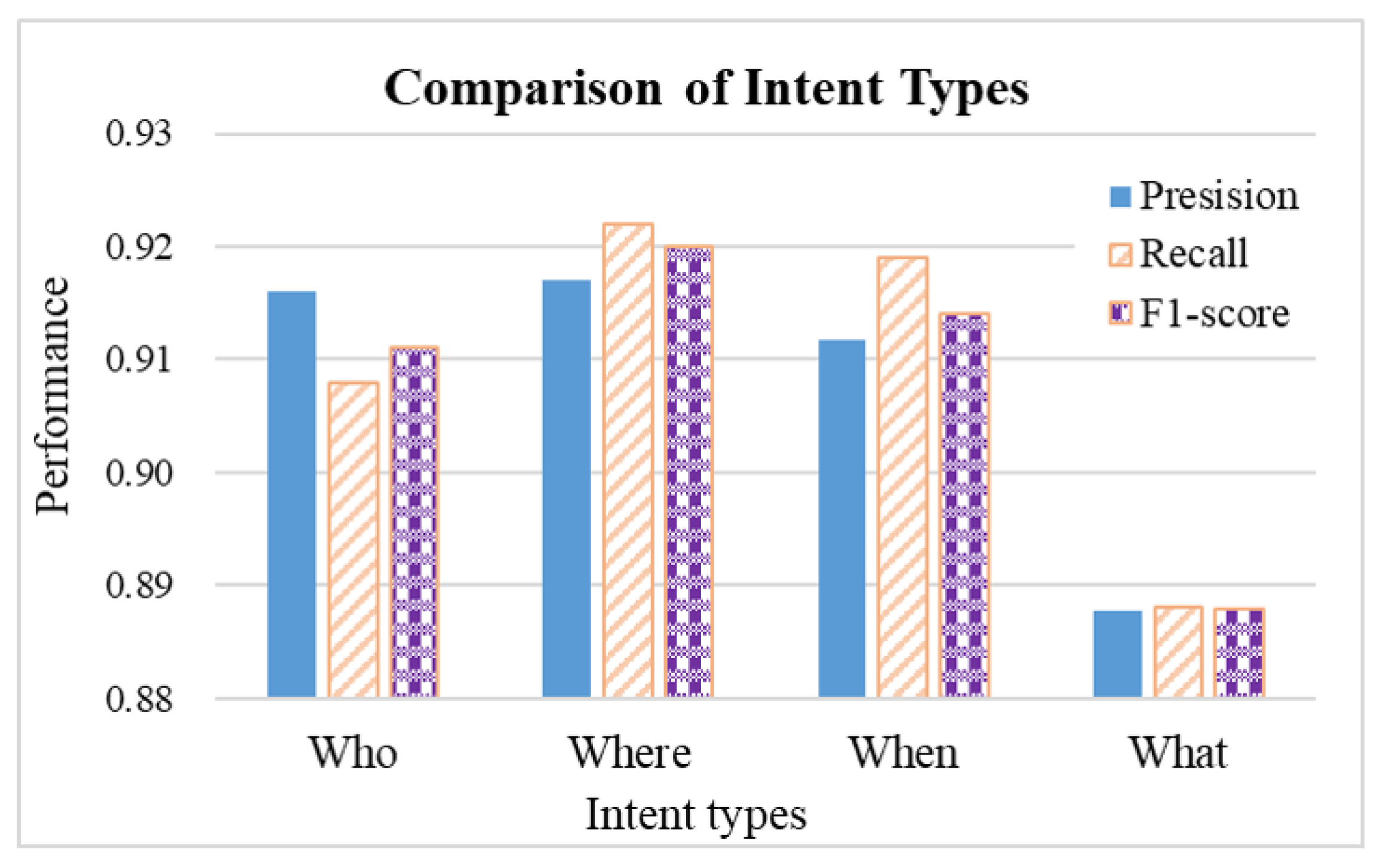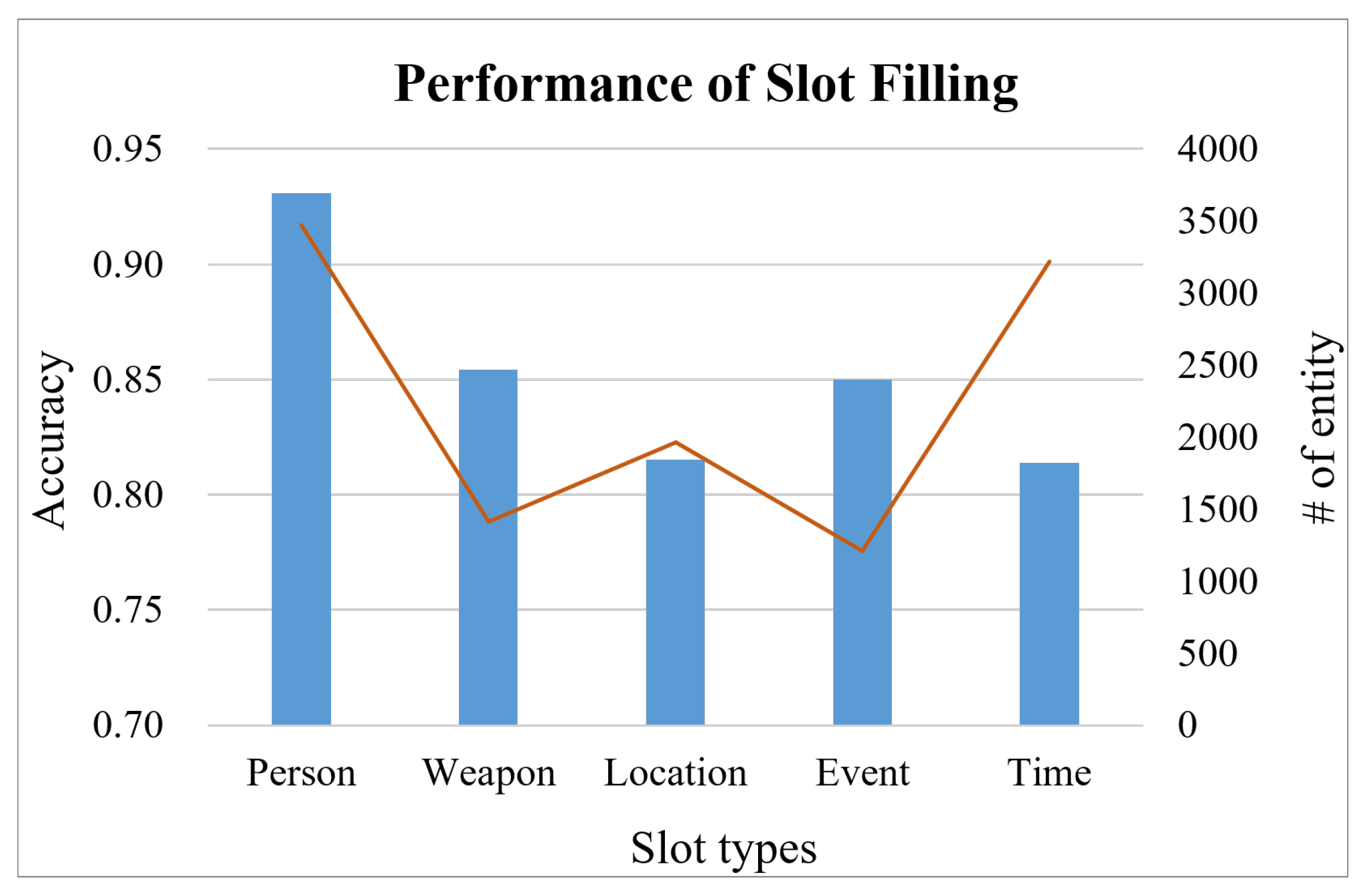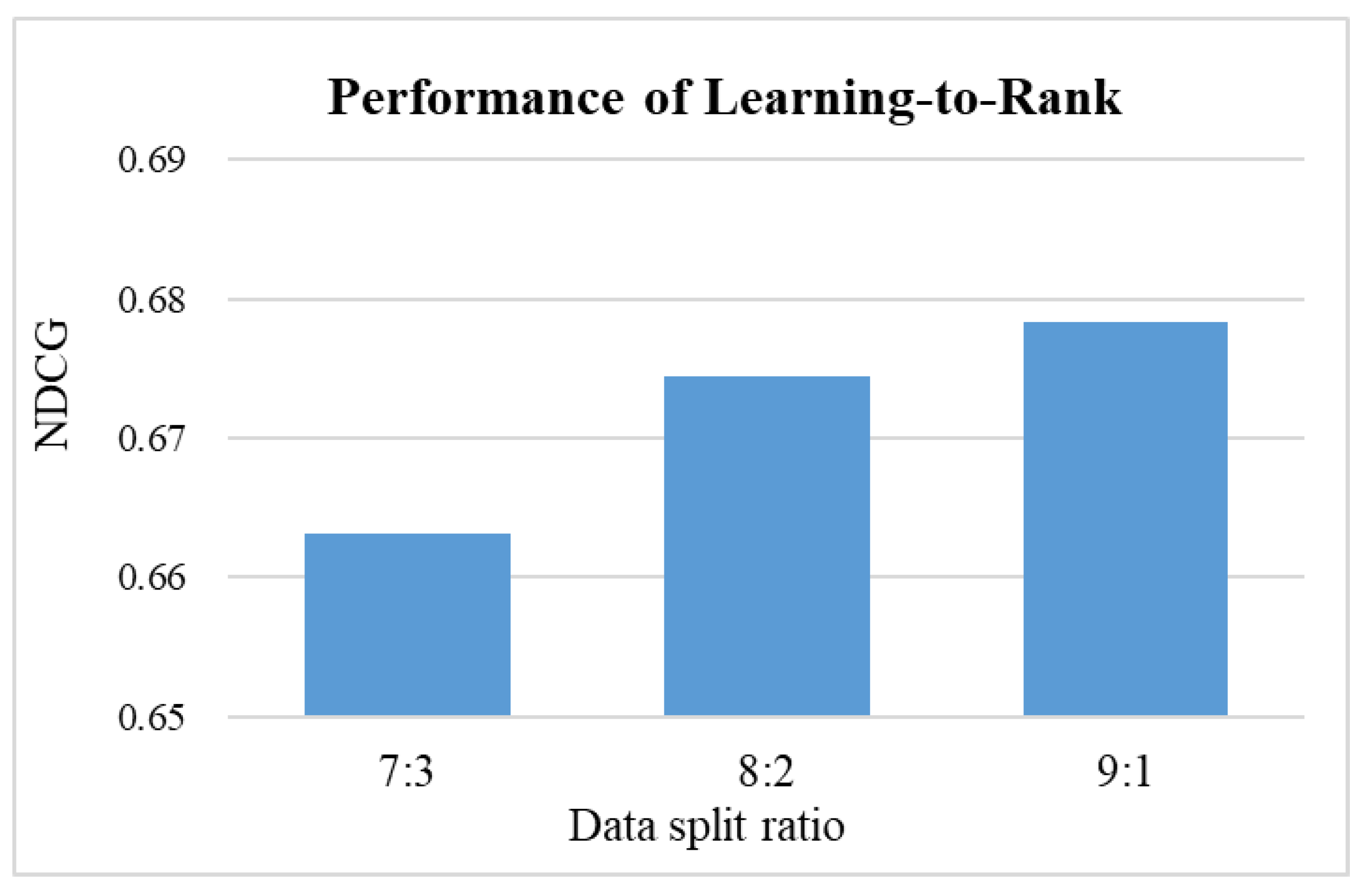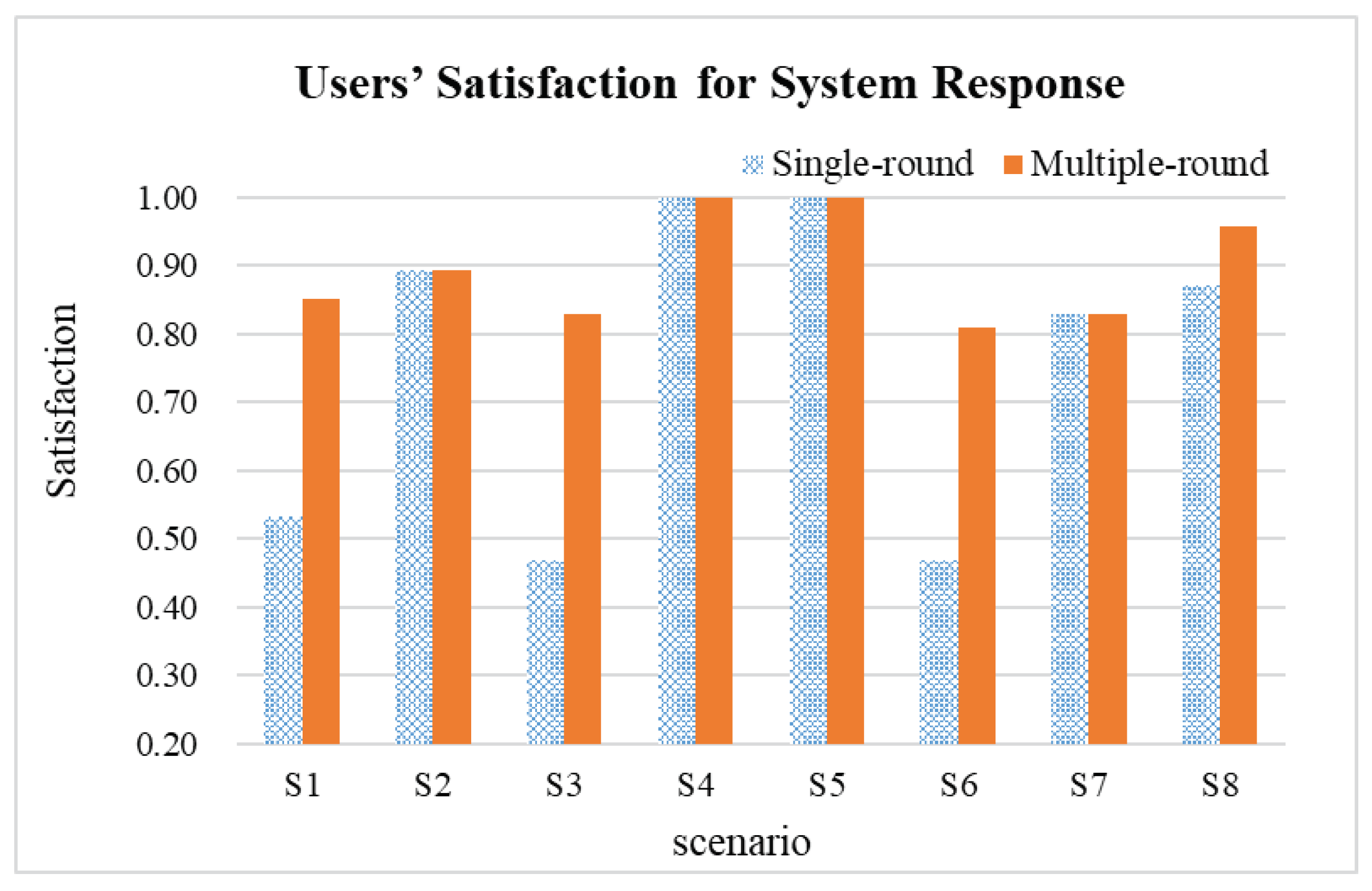1. Introduction
Breakthroughs in artificial intelligence and natural language processing (NLP) have made it possible for conversational agents to provide appropriate replies in various domains, helping to reduce labor costs [
1,
2,
3,
4]. Task-oriented conversational agents, in particular, are of great interest to many researchers. According to a 2018 VentureBeat article [
5] over 300,000 chatbots are operating on Facebook. In addition, a 2021 Userlike survey showed that 68% of consumers liked that chatbots can provide fast answers or responses [
6]. As a result, text-based conversational systems or chatbots have become increasingly common in everyday life. Task-oriented conversational AI use NLP and NLU to perform intent detection and response generation based on domain-specific information, and are mainly used in entertainment [
7], finance [
8], medicine [
9,
10], law [
11,
12], education [
13], etc.
Combat training emphasizes timeliness, coupled with the ever-changing battlefield. As a result, effectively predicting the combat information required by soldiers has become one of the key technologies on the frontline battlefield. Operators need to send and receive the type of data they want to enhance their situational awareness [
14]. However, it is costly and practically difficult to provide a human assistant to every operator [
15,
16]. At the 2017 National Training and Simulation Association (NTSA) conference held in Florida, AI experts and military officials discussed valuable applications of AI in military training [
15]. Considering that future battlefields and combat scenarios will be increasingly complex and difficult to navigate, the ability to use AI to design extremely realistic, intelligent entities that can be immersed in simulations will be an invaluable weapon for the Navy and Marine Corps. To reduce the risk to personnel in practice, since 2021, the U.S. The Navy has been planning to develop virtual assistants to assist in submarine hunting (
https://voicebot.ai/2021/02/10/the-us-navy-wants-a-virtual-assistant-to-help-hunt-submarines/ (accessed on 29 January 2022)). For example, sonar operators on ships must manage the complexity of sonar technology and set settings based on weather, location, etc. Hence, the Navy wants to utilize artificial intelligence to enhance the operating system, improving sonar detection and reducing training costs. These information-processing AI systems can be tailored to specific industries.
In a recent study, the three main types of Human–Machine Interfaces (HMI) were text-based systems, voice-based systems, and interactive interface systems [
17,
18,
19]. For example, Dr. Felix Gervits from the Army Research Laboratory worked with the U.S. Army Combat Capabilities Development Command and the University of Southern California’s Institute for creative technologies to develop autonomous systems (
https://eandt.theiet.org/content/articles/2021/04/military-bots-could-become-teammates-with-real-time-conversational-ai/ (accessed on 29 January 2022) [
20] to derive intent from a soldier’s speech via a statistical language classifier. By combining NLU with dialogue management and having the classifier learn the patterns between verbal commands, responses, and actions, they created a system that could respond appropriately to new commands and knew when to request extra information. In addition, Robb et al. [
21] proposed a conversational multimodal interface by combining visual indicators with a conversational system, providing a natural way for users to gain information on vehicle status/faults and mission progress and to set reminders. The system can be used for operations in remote and hazardous environments.
During military training missions, soldiers must follow guidelines or personnel instructions. However, the overloading information may not be understood and completed effectively. In addition, traditional retrieval systems may delay user action. Hence, we constructed a conversational agent over a set of military scenarios that enables users to operate on constantly evolving battlefields and to obtain the information they need through conversation. Based on the survey of conversational systems in [
22], we aim to design task-oriented dialogue systems for application in military scenarios, focusing on question answering with martial training intent and relevant entity information. Therefore, conversational goals for social and entertainment purposes, such as greetings, entertainment, and advertising, are outside the focus of our system. Therefore, the ability of a military conversational AI to correctly detect its user’s intent and identify entities in a sentence will determine whether it can successfully reply to users.
One challenge for intent detection is that the questions of military users can be terse and ambiguous [
23]. Furthermore, the answer often depends on the context of the conversations. To narrow down the range of possible intent types, we first defined the range of applications for the types of intent it was meant to detect, and then classified and annotated the conversational data. In general, although the users’ queries are short, most will mention the important entities. The role of slot filling is to identify and annotate the entities in the sentence, e.g., persons, events, times, locations, and weapons. As for the response provided by the system to the user, the challenges are to choose the most appropriate answer and to generate questions that require explicit information when missing the primary entity from the user’s query.
To enable the task-oriented conversational system, the architecture comprises four modules based on a pipeline strategy: (1) slot filling, (2) intent detection, (3) retrieval-based answering, and (4) query generation. For the (1) and (2) modules, we trained by our prepared dataset by named-entity recognition (NER) models and a support vector machine (SVM) classifier [
24], respectively. The (3) module is used by the BM25 algorithm [
25] to retrieve the Military List and then rank the most appropriate solution using the Learning to Rank (LTR) model [
26]. For the final module, we adopted the template-based question generation for the database of the Army Joint Task List (AJTL) according to the user’s intent.
The performance of our military conversational system was experimentally evaluated in terms of the performance of its intent detection, slot filling, LTR modeling, and question generation modules. The system performed well based on both quantitative and qualitative metrics. Therefore, this study established a new approach for the development of military conversational systems. The proposed architecture could also be trained using other domain-specific datasets to expand its scope of applicability. The contributions of this study may be summarized as follows.
A task-oriented conversational system was designed based on the practical needs of military tasks. As its module functions and datasets are mutually independent, it is possible to use this architecture to accelerate the training of domain-specific conversational systems in other domains, as one simply has to replace the dataset.
This study defined the four core tasks of a conversational system and used machine-learning technologies to enable the realization. They included using NER models for slot filling, a classifier for intent detection, answering by the retrieval-based and learning-to-rank (LTR) model, and generating new queries by the template-based method.
The experimental results highlight the performance of the intention detection, slot filling, sentence ranking, and the overall user satisfaction for the conversational system. The result can serve as a promising direction for future studies.
The remainder of this paper is organized as follows.
Section 2 describes related work and technologies.
Section 3 introduces the proposed architecture and functions.
Section 4 presents the experimental results evaluating.
Section 5 summarizes the tasks and discusses future directions.
2. Related Work
This section reviews related work of conversational AI and military conversational systems. As well as tasks and models for NLU, emphasizing intent detection and slot filling, we conclude with a review of response generation methods.
2.1. Conversational AI
The rapid development of AI technologies has increased academic interest in human–computer interfaces, with applications ranging from domain-specific settings to open-domain conversations. In the business world, personalized AI assistants such as Siri (Apple), Assistant (Google), Cortana (Microsoft), Messenger (Facebook), and Alexa (Amazon) have become increasingly common. Owing to the extensive labeling of conversational databases and the application of deep-learning and NLP techniques, conversational systems have made considerable progress in understanding the semantics of natural language and contextual reasoning. We divide conversational AI into several categories according to their purposes as the following.
Conversational AI, which are also known as chatbots, may be divided into task-oriented or non-task-oriented dialogue systems [
27]. Task-oriented dialogue systems are meant to help users perform a specific task, e.g., intelligent food ordering, legal queries [
28], and smart customer service. In addition, they usually have domain-specific conversational dialogues and knowledge bases.
Non-task-oriented dialogue systems (e.g., chatbots for the elderly or children) are meant to provide reasonable responses to users and thus provide entertainment and have open-domain dialogues that are not specifically constrained in scope. The first chatbot in the world was the Eliza chatbot in 1996 [
29], which used simple dialogue to mimic a psychologist conversing with a patient. In 2017, Fitzpatrick et al., developed Woebot [
30], a cognitive-behavioral therapeutic (CBT) chatbot, which was able to converse with patients and provide CBT assistance. Zhang et al. [
31] proposed a unified conversational search/recommendation framework called “System Ask—User Respond,” which was trained using a large collection of user reviews in e-commerce. They then evaluated the performance of this framework using metrics such as the Normalized Discounted Cumulative Gain (NDCG).
Task-oriented dialogue systems are typically designed with a “pipeline” consisting of four modules: a NLU module, dialogue state tracker, dialogue policy learning module, and NLG module [
27]. Recently, some workers have proposed end-to-end frameworks to expand the expressiveness of the state space and support dialogue beyond domain-specific corpora [
32]. For example, Zhao and Eskenazi proposed an end-to-end framework that used reinforcement learning and policy learning to optimize the dialogue system for dialogue state tracking. They tested this framework using a 20-question game, where the conversational system asked the user a series of yes-or-no questions to find the answer to a specific question.
There are three main approaches for conversational response generation [
4]: rule-based approaches, retrieval-based approaches, and generative approaches. A rule-based system often requires a large amount of manual design and labeling work and therefore has the highest costs. Retrieval-based conversational AI uses keyword matching with machine learning or deep learning to determine an optimal predefined response [
33]. Finally, generative conversational AI can be trained in multiple stages using supervised/unsupervised learning, reinforcement learning, or adversarial learning. Recently, Zhang et al. [
34] presented a graph-based self-adaptive conversational AI; it used a knowledge graph whose nodes and links represented key entities and semantic relationships, respectively, as a dynamic knowledge base. It allowed the system to gain knowledge through conversations with end-users. Based on the definition above and the category of conversational AI, the system presented in this work may be characterized as a domain-specific (military) task-oriented dialogue system. To ensure that the dialogues produced by the conversational AI are compatible with the expectations of military tasks, we used a pipeline design and retrieval-based response generation method.
Military-domain task-oriented conversational systems can be divided into three types according to their mode of interaction: voice-type, text-type, and interactive interface-type systems. A few successful examples are described below. The Siri chatbot developed by Apple in 2011 began as a part of the “Cognitive Assistant that Learns and Organizes” project funded by the Defense Advanced Research Projects Agency (DARPA); by using perceptual and experiential learning, Siri reduced the information overload faced by battlefield commanders. It has since become a virtual voice assistant of national importance. With the development of expert assistant systems and the application of text-based conversational AI in military applications, IBM’s Watson system came to be used to provide occupational information to US military members and help them transition from active duty into civilian life. In 1998, DARPA presented a dialogue system based on conversational multimodal interfaces, which allowed its users to perform operational tasks more efficiently [
28].
Due to the lack of relevant literature on military dialogue systems, this study summarizes relevant research on military dialogue systems in different periods in the past, as shown in
Table 1. For example, Roque et al. [
35] in 2006 proposed a spoken dialogue system that can engage in Call For Fire Radio dialogues (Radiobot-CFF) to help train soldiers in proper procedures for requesting artillery fire missions. They provided three modes: fully-automated, semi-automated, and passive mode, as the radio operator in a simulated Fire Direction Center (FDC) takes calls from a forward observer for artillery fire in training exercises.
The Hassan system [
36] proposed by Gandhe in 2009 is a set of tactical question-answering dialogue systems, including a management interface for creating dialogue content and a dialogue manager, which can be used to build multiple virtual characters for tactical questions. The experiment consisted of 19 dialogues and 296 utterances. Furthermore, the experts expanded the range of possible responses provided by the virtual character by annotating other candidate utterances according to need. However, the system lacks the capabilities of question generation.
MIRIAM is a conversational multimodal interface developed for command-and-control systems proposed by Robb et al. [
21]. The system improved situational awareness by providing information in multiple modalities (including audio, images, and text) to clarify the textual ambiguities that often arise in natural language and improve understanding. Therefore, multimodal conversational AI could become an important trend in the design of military conversational systems. The recent example of a successful military conversational AI would be the human-robot navigation system of Gervits et al. [
20].
2.2. Intent Detection and Slot Filling
In a conversation, the queries provided by the user are usually relatively short. Therefore, the dialogue system must first determine the aim or intent of the question. However, the information within the query may be incomplete or stated implicitly. Suppose the dialogue system does not possess the knowledge or context necessary to answer the question. In that case, it may require several rounds of dialogue to redress these issues and confirm the user’s intentions.
In 2018, Zhang et al. [
31] proposed a “circular” conversational architecture, where the dialogue system clarified a user’s intentions through several rounds of dialogue. Intent detection pertains to the determination of intent by analyzing the structure of the question [
37], e.g., by “5W2H” analysis (why, what, where, when, who, how, and how much) [
38], to improve the accuracy of the retrieved answer. Furthermore, as the information contained by the query is critical for determining the correct answer, NER techniques can be used to identify key 12 persons, events, times, places, and objects and narrow down the query’s scope.
Intent detection may be performed using statistical or rule-based methods. For example, Setyawan et al. [
39] used Naïve Bayes and logistic regression machine-learning methods to perform intent detection, with the term frequency-inverse document frequency being the classification feature. In 2012, Wang et al. [
40] converted short snippets into vectors to perform intent (sentiment) classification and compared the SVM, Naïve Bayes, and continuous bag-of-words methods. The typical representative one of the supervised learning methods is the SVM. Over the past 10 years, many scholars have uses SVM as a comparative method for intent classification or sentiment analysis, and the summary references are as shown in
Table 2. In addition, deep-learning models have also become commonplace in intent detection. Nigam et al. [
41] used a recurrent neural network to perform multi-staged named-entity learning and then used the named entities as classification features.
Slot filling is another critical task in dialogue systems, as it provides semantic information and helps the conversation system determine which bits of information in a sentence should be searched for. In previous studies, slot filling has often been performed using generative models (such as the hidden Markov model) or discriminative models (such as the conditional random field (CRF) model) to estimate the conditional probabilities of slot labels in a sequence. However, with the emergence of deep-learning models, bidirectional recurrent neural network (RNN) models and long short-term memory (LSTM) models trained with contextually annotated sentences are now used for slot filling. In recent studies, CRF models have been combined with RNNs to train slot-filling models for unseen semantic labels and multi-domain tasks, enhancing their performance. Yang et al. [
49] presented an intent-aware neural ranking model, which used the “Transformer” architecture to perform language representation learning and to analyze user intent patterns in information-seeking conversations.
Intent detection is usually viewed as a supervised classification problem, that is, mapping a sentence to some class within a finite set of classes. Slot filling, in contrast, is viewed as a token sequence labeling problem. Traditionally, intent detection and slot filling are performed separately or in a pipeline. Recently, some studies have investigated the use of joint models for simultaneously performing intent detection and slot filling [
50], and have proven that these tasks are closely related to each other. Compared to the pipeline approach, joint models are less susceptible to error propagation between the intent detection and slot-filling models. In addition, they can be trained and tuned as a single model. However, joint models cannot be easily generalized to unseen data due to variations in natural language expressions for the same intent.
Furthermore, domains and label sets can change over time in real-world applications. There is a lack of publicly available task-oriented datasets among the conversational corpora used for training. Moreover, the available datasets are limited to a few specific domains. These corpora may be divided into two types: the first type comprises user–system conversations, such as the Air Travel Information System [
51] and WOZ2.0 [
52]; the second type includes simulated human–system dialogues subsequently and manually converted into natural language, such as the machine-to-machine dataset [
53].
2.3. Response Generation
NLG is the phase in NLP where task-oriented dialogs are completed to meet user needs. Response generation by the system can be performed using retrieval-based or generation-based models. Retrieval-based answers generate dialogue by retrieving the best responses from the corpus through a ranking function and often have highly fluent and informative answers. However, it tends to be repetitive and cannot handle semantics outside its corpus. On the other hand, generation-based conversational systems use logic to infer spoken responses and are therefore not bound by response templates. Traditionally, NLG always involves sentence planning, where the input semantic symbol is mapped to an intermediary representation of the utterance (e.g., a tree-like or template structure). The intermediary process is then converted into the final response through surface realization.
In 2002, Sneiders [
54] presented a template-based automated answering model. The model considered four entities (human names, locations, organizations, and times) and used NER to extract information (keywords). The keywords were then matched to question templates to create answers. However, answer generation alone may not produce an adequately correlated response with the original question. To address this problem, reference [
55] used the co-occurrence of technical terms in a corpus to infer whether they were correlated. In 2003, Fiszman et al. [
56] presented the SemRep system, which used manually-listed template rules for verbs to identify potential semantic relationships in a sentence and used identification criteria to select relevant technical terms and phrases.
Bhoir and Potey [
57] proposed a heuristic retrieval-based conversational system for retrieving the most relevant answers from a predefined corpus based on a user’s input and used complete sentences as candidate answers. It also considered the type of answer to select an appropriate response to the user. Choosing a proper reply is the most critical problem in question-answering systems, and the reaction must also be clear and concise. Therefore, selecting only the most critical information when formulating a reply is necessary. In another study [
58], a similarity approach was used to predict whether a message was a reply to another message. This approach was validated by comparisons with a trained bidirectional encoder representation from the transformers model, with conversations generated by a bidirectional LSTM and RNN. The authors found that this approach helps to improve the understanding of the context.
Recently, there has been increasing interest in finding distributed vector representations (embeddings) for words, that is, by encoding the meanings of text into vectors. The text may range from words, phrases, and documents to human-to-human conversations. In 2017, Bartl and Spanakis [
59] used a locality-sensitive hashing forest, an approximate nearest neighbor model, to generate context embeddings and find similar conversations in a corpus. The candidate answers were then ranked.
In 2018, Juraska et al. [
60] presented a sequence-to-sequence natural language generator with an attentional mechanism and was able to produce accurate responses for a variety of conversational domains. In 2019, Song et al. [
61] from Microsoft proposed the method based on the concept of pre-training and sequential neural networks. This method masked a segment of a random length and used an encoder–decoder attention mechanism to generate responses.
In 2020, Wang et al. [
62] from Tencent proposed a deep-learning-based TransDG model for generating Chinese conversations. This model performed question–answer and semantics-named entity matching within its knowledge base and then selected the optimal strategy for response generation.
A recent study showed that template-based conversational AI faces two key challenges: (1) constructing a system grammar that balances the expressiveness necessary to conduct a task with the ability to infer parses from natural language correctly; and (2) dealing with parse ambiguities. Seungwhan et al. collected a new open-ended dialogue-KG parallel corpus called OpenDialKG [
63], where each utterance from 15,000 human-to-human role-playing dialogues was manually annotated with a ground-truth reference to corresponding entities and paths from a large-scale knowledge graph with more than one million facts. They also proposed a DialKG Walker model for learning the symbolic transitions of dialogue contexts via structured traversals over the KG, and used an attention-based graph path decoder to predict the entities. Bockhorst et al. [
64] addressed parse ambiguities by using a context-free grammar called episode grammar; the system constructed a semantic parse progressively for a multi-turn conversation, where the system’s queries were derived from the parse uncertainty.
3. Methodology
This work proposes a conversational system architecture that uses machine-learning techniques through a Chinese corpus for military training missions. It includes the mission list of the joint training management system, the military dictionary, and the Army Joint Task List (AJTL). As the implementation of this system is independent of its domain and language, it can be used to enable conversational systems in other fields or languages by changing its corpus.
3.1. System Architecture
This study aims to develop a conversational AI for quickly answering soldiers’ questions in the military training mission and supporting multiple conversation rounds. The architecture of our conversational system is shown in
Figure 1. The user’s query is first parsed by NLP, followed by a slot-filling module, which identifies important entities, and then the intent type is detected by the intent detection module. The system performs retrieval-based answer generation through the extracted entities and intents. The retrieval-based question-answering system ranked and selected the optimal responses. If the user confirms the answer is clear, take action; otherwise, the system will generate a new query to verify the user’s intent. Slot filling and intent detection are the NLU stages for understanding, and retrieval-based answering and query generation are the NLG stages for responding. In the NLU stage, we use the CRF and SVM models to train slot-filling and intent-detection modules, respectively, which are practical and easy to implement due to the limited training information set. In addition, we make some summaries of the use of these models in related research. In the NLG stage, we use a learned ranking method to obtain retrieval-based answers. There are two basic types of generating sentences: extracted and abstract. This method is determined according to the greater probability of finding and querying within the existing corpus. The advantages of this method are that the grammar is relatively smooth and easy to understand and does not require a large number of training datasets—the main reason for responding to build mods. We use a template-based strategy in the query generation module. This template-based query generation method may propose a new query for the missing intent or entity and user to be confirmed with the user, that is, for the intent and entity to continue the dialogue, with the intention to avoid generating a new query and diverging context.
3.2. Slot Filling and Intent Detection
Figure 2 illustrates the flow of a user’s query. In the query “何時將完成後備部隊動員任務 ? (When will the reserve force complete the mobilization task?),” entities such as “何時 (when)” as B-time, “後備部隊 (reserve force)” as B-unit and I-unit, “動員任務 (mobilization task)” as B-event and I-event were annotated. Slot labels are labeled using the BIO format: B indicates the beginning of a slot span, I the middle of a span, and O indicates that the label does not belong to a slot. In addition, the query intent of this sentence is “when”.
To ensure the conversational system is able to deliver the correct intents and related entities, the system analyzes a soldier’s utterances first to identify the entities mentioned and match them with intents stored in the mission list database, and then orders the appropriate response sentences. Because traditional retrieval systems rely on retrieving full-text search results for user queries, retrieval models are based on the similarity between the query and the text (e.g., vector space models). Therefore, the user may miss the correct answer because the intent of sentences with high similarity may not match the intent of the user’s question. In other words, we prioritize intent and entity accuracy before evaluating similarity.
3.2.1. Slot Filling
The slot-filling task, in contrast, was defined as a sequence labeling problem, that is, an NER problem. We trained used five kinds of entities by the CRF model. Considering the amount of data and the implementation of integrating multiple modules, we choose the CRF-based method as the baseline for slot filling.
During the preprocessing phase, the CkipTagger (
https://github.com/ckiplab/ckiptagger (accessed on 29 January 2022)) tool was used for Chinese word segmentation and part-of-speech (POS) tagging for the user’s query. The CRF toolkit was performed to train five NER models. Five types of slots related to military missions were defined: the military unit and location, the name of military personnel (including job titles and ranks), the name of military event tasks, the name of the weapon, and time. As shown in
Table 3, There are six types of features: POS tagging, vocabulary, specific terms, verbs, quantifiers, and punctuation. We match them to entities for vocabulary and specific terms, and the vocabulary source is the Military Dictionary. For verbs, quantifiers, and punctuation, we use them to determine the boundaries before and after entities. In summary, we trained five CRF models to predict five entities (i.e., location/unit, person, event, weapon, and time) for slot filling. The CRF model was then used to estimate the conditional probability of the sequence, as shown in Equation (
1).
If it is assumed that x and y are random variables, given an observed sequence X, is the conditional probability distribution of the hidden sequence Y, whose probability estimate in the state t depends on that in the state . is a normalization function for normalizing the value of .
3.2.2. Intent Detection
In this study, we adopted the SVM multi-class classification method [
65] for intent detection. The algorithm constructs
k SVM models, where
k is the number of classes. All the examples in the
mth class with positive labels are used to train the
mth SVM and all the other examples with negative labels. Formally, given training data (
), …, (
), where
∈
,
i = 1, …,
l, and
y∈ 1, …,
k is the class of
, the
mth SVM solves the following problem:
where the training data
are mapping to a higher dimension space by the function
and
C is the penalty parameter.
Here, intent detection is regarded as a multiclass classification problem, with the intent in a query consisting of four parts: who, where, when, and what. As we did not consider the possibility of multiple intents in one question, the hard classification performed the intent prediction with the highest probability of the query. SVM is one representative machine classifier for supervised learning methods. Many scholars use SVM as a comparison or combination method in recent studies, as discussed in Refs. [
40,
46,
47,
66,
67]. However, despite these years of research, intent detection is still challenging. The classifier is used for intent detection by a SVM classifier, as SVMs are accurate for this task.
After extracting entities, there were 12 types of features for training user’s intent, as shown in
Table 4. Features 1–5 were the five types of entities extracted by NER models. Regarding Features 6–8, we used the Military Dictionary to match whether the query sentence contains military words and quantifiers. Features 9–12 were Common interrogative terms in Chinese. Formally, the multi-class classifier is used to predict an unseen sample
x with labels 1 to
k, which assigns the highest confidence score, as shown in Equation (
4). We used a simple one-hot encoding to facilitate the classifier’s training for nominal features, with matched features being one and unmatched features being 0.
For a conversation system, there is difficulty remembering conversational intent from one sentence to the next. In other words, the procedure typically treats each query from the user as a new dialogue state. To alleviate this problem, our system stores intents and entities extracted from one round of conversations and intents and entities extracted from previous rounds of conversations. When the system confirms whether the response meets the user’s information needs, if the user gives a negative reply, the intent and entity of the query are stored to avoid forgetting.
3.3. Response Generation
After extracting the user intent and filling the slots, the second step is to answer the user using a retrieval-based response module. Suppose no intent or relevant entity was identified in the previous step. In that case, the system uses a template-based query generation module to ask the user for additional information to retrieve an appropriate answer. In practice, we use the Elasticsearch full-text search tool to build a retrieval model in the Chinese military domain. The model is built using the Okapi BM25 algorithm. The model determines the most appropriate response based on the correlation between query Q and database document D, as shown in Equation (
4).
where
IDF denotes the inverse document frequency in this equation, and
is the average length of all texts.
In the retrieval system, the entities extracted from the user query are used as the keywords to perform full-text retrieval. The top 10 most relevant results were then selected using the Learning-To-Rank Answering (LTRA) apporach, as shown in Algorithm 1. The input to the retrieval model is the searched sentences S = {,…, }, query intent , and entities E = { , …, }. First, intent prediction is performed for each sentence. If a sentence j intends to be the same as , the candidate sentence j is kept; otherwise, it is discarded. The LTR model ranks the candidate sentences and considers the top k candidate sentences as the most suitable replies.
The LTR model was implemented using the LambdaMART algorithm [
68]. LambdaMART is a listwise LTR that combines the LambdaRank and Multiple Additive Regression Tree (MART) algorithms, transforming the search candidate ranking problem into a regression tree problem. To train candidate sentences for ranking, we prepared 10 features, as shown in
Table 5. Features 1–5 represent the five NER models for extracting entities from candidate sentences. Features 6 and 7 are used to determine if the candidate sentence matches the military document names and units in the Military Dictionary; the results are displayed as boolean values. Feature 8 represents the longest common subsequence (LCS) between the user query and candidate sentences, as shown in Equation (
5). Feature 9 denotes the similarity between the user query and candidate sentence, as shown in Equation (
6). Feature 10 denotes the term frequency-inverse document frequency (TFIDF), which is used to calcuate the word importance for user’s query and sytem answers based on the corpus, as shown in Equation (
7).
| Algorithm 1 Learning-To-Rank Answering. |
- 1:
Input: search sentences S, query intent , entities E - 2:
Output: ranked sentences - 3:
Initialize candidate set C is empty - 4:
for sentence from S do - 5:
if sentence intent then - 6:
candidate set C∪ sentence j - 7:
end if - 8:
end for - 9:
while candidate set do - 10:
Rank sentence by the LTR model - 11:
end while - 12:
Return top-k sentences =
|
The above calculates the LCS for input sequences
and
, where 1
and 1
.
In the above, X and Y are discrete random variables, that is, the correlation between the entity sets of the user query and the candidate sentence.
The question generation module generated new queries based on the template-based representation of the intent–entity relations of queries. The structural composition was viewed as a set of intent–entity relationships within the state space, as shown in
Figure 3. The intents of a question included who, where, when, and what, whereas named entities were in six types: person, unit, event, time, weapon, and document (Doc). Candidate sentences could be formed based on the occurrence probabilities of the intent–entity relationships. For example, the intent “who” and entity “event” was related by “be responsible for” in “the commander (who) is responsible for this combat readiness mission (event).” In general, as a response should also have a person as the intent (who) and a combat readiness mission (event) as the entity, the candidate sentences should be ranked according to the presence of the “event” entity and “who” intent in these sentences.
In the question generation module, the predicted intent types and the queried entities are combined according to the intent–entity relations shown in
Figure 3.
Table 6 shows some examples of such parsed sentences. Brackets correspond to slot-fill annotation entities, and bold corresponds to intent types. Templates can be applied in various combinations. To select the best new question from candidate sentences generated by multiple templates, we define Equation (
8) to score each query–new-question pair. The higher the score, the stronger the semantic relevance between the newly generated question and the original query.
In this equation, i refers to the candidate sentence generated by the i-th rule for the same intent; is a weighting parameter that ranges from 0 to 1; LCS is the longest common subsequence between the user query and generated query; Cosine is the cosine similarity between the user query and generated query; and TFIDF is the importance of words around user’s query, which is calculated the product by term frequency and inverse document frequency.
4. Experiments
This section evaluates the performance of the proposed system, including describing the datasets and metrics used, the experimental evaluation of the intent detection and slot-filling modules, and the response generator’s ranking performance evaluation. Finally, the overall performance of the dialogue system is discussed.
4.1. Datasets and Measures
A total of 1307 human-labeled sentences are included in the experimental dataset used for intent classification (who, where, when, and other).
Table 7 shows the four types of intent quantitative sentences. As shown in
Table 8, the experimental datasets were used to train the five NER models, including people, weapons, places, events, and time. The intent detection and slot-filling tasks in the NLU stage are evaluated using F1-score (Equation (
9)) and accuracy (Equation (
10)). In the following equations, true positive (TP) and true negative (TN) are the numbers of accurately predicted positives and negatives, respectively. Conversely, false positive (FP) and false negative (FN) are the numbers of wrongly predicted positives and negatives, respectively. Thus, Precision = |TP|/|TP + FP| and Recall = |TP|/|TP|+|FN|.
The LTR model was evaluated using the normalized discounted cumulative gain (NDCG), which gives the normalized relevance score of the files retrieved by the search engine at each rank position. Files closer to the top are given a higher weight (and therefore have a greater degree of influence on NDCG), as shown in Equation (
11).
where
IDCG is ideal discounted cumulative gain, and
represents the list of relevant documents in the corpus up to position
p.
DCG is based on the principle that highly relevant documents appearing lower in a search result list will be penalized by having their relevance grade reduced logarithmically proportional to their position in a search result list. Finally, the query generation module is evaluated by quantifying user satisfaction.
4.2. Performance of the Intent Detection and Slot-Filling Modules
SVM models are used to perform multi-class classification. The dataset is randomly divided into training and test sets in three different proportions. According to the results shown in
Figure 4, the 9:1 ratio outperforms the 7:3 ratio in terms of F1 score and accuracy, and achieves 90% accuracy. The performance for predicting the four intents is then performed based on the model trained with a data ratio of 9:1, as shown in
Figure 5. The multi-class classifier had the highest F1 score for “where” intent (92%), followed by “when” (91.4%), “who” (91.1%), and finally “what” (88.8%). The average F1-score of the classifier was 90.1%. Due to the limited amount of training data (1307 sentences in four categories), the F1 performance of the trained intent detection model is 88 91%. However, from the perspective of the learning curve (dataset splitting rate), the performance improves as the amount of training data increases. Further comparing the performance of each category, we can see that the “What” category has the most errors, followed by “Who” and “When”, and “Where” has the best performance. We analyzed the possible reasons and found two: one is language. For example, in Chinese grammar, the query for “What” is more complex than the other three categories, which may include “Why”, “How”, “which”, etc. Another possible reason is that when the user’s query has multiple intents, the classifier will only predict the class with the highest probability, so the number of false negatives for the “what” intent increases.
The performance of the NER model is evaluated by performing five-fold cross-validation on the dataset.
Figure 6 shows the performance of NER in recognizing military names, weapons, military locations, military events, and time entities. In terms of F1-score, the five models have the highest accuracy (0.943) for person names, followed by time. Conversely, it performed slightly worse at identifying military event, at 0.848.
4.3. Performance in Response Generation
Next, it evaluates the performance of retrieval-based answers. First, a question-and-answer dataset of 180 military joint tactical action lists is manually collected as standard answers. Three sentences are then randomly selected for each query, resulting in four candidates. Responses in the training dataset are ranked from 1 to 4, where 4 represents the highest score for the questions–answer pairing. We use the NDCG indicator as to the evaluation indicator for the LTR model. The training and testing datasets are divided into three different scales, and the experimental results for each scale are shown in
Figure 7. Since the 9:1 ratio gives the highest NDCG score, this model is used as the LTR model for our conversational system.
Finally, eight military scenarios are randomly selected from 40 question-and-answer test data for performance evaluation. The
Table 9 shows questions and answers for eight military scenarios. The intent is first identified for each question, and then responses are generated based on the extracted intents and entities and intent–entity relationships. Each intent may generate multiple sets of candidate sentences, and the first set of responses is the candidate sentence with the highest relevance to the query. The results of the dialogue were qualitatively assessed by 47 military-related personnel. The proportion of responses that meet user needs is shown in the
Figure 8. If the user is not satisfied with the first response, the dialogue system generates a new query and then provides the second answer. Experimental results show that, on average, 66% or more of users are satisfied after the second round of conversations. Therefore, new queries generated by the system in the second round of dialogue (when the first answer is not satisfactory) significantly improved user satisfaction.
4.4. Discussion
Here, we conduct an error analysis of the module performance and discuss the challenges of research and limitation. For the intent classification module, we found that the “what” category has the highest error rate (12%) because there are some queries with different interpretations, such as “why”, “how much”, “how to do”, etc. For example, “how many days can each cavalry company unit fight independently?” “How many exchange centers and medium-sized communication centers can a communication force establish?” These false-negative examples of the “what” leads to lower recognition performance than other classes. It will be possible to further segment the user’s intent in the future to guarantee that every feature of that intent is clearly defined.
For the slot-filling module, the accuracy for five types of entities is identified by the military personal name as the highest (0.917), followed by time (0.901), location (0.823), weapon (0.788), and military event (0.776) as the lowest. There are two main reasons for the poor attribution of military events: (1) Event names are longer than other entities, making it more challenging to identify the limits of the entity. Still, the system identifies part of the names of military activities. (2) The event name contains time or location, which is misjudged as another entity.
For the retrieval-based answering module, we use the learning-to-rank method to achieve results. From the learning curve point of view, with the increase in data, the efficiency of the system response improves (NDCG = 0.678). Candidate sentences are added only when the intent of the sentence is the same as the intent of the user’s query. Then, we adopt these entities in the sentence as sorting features, and finally, sort them based on the LambdaMART algorithm. As we analyze why the correct sentence is not ranked first, we discover that pronouns may represent entities in sentences or omit them; thus, some candidate sentences do not identify entities related to the query, resulting in a low ranking score.
Based on the methods comparison in related literature, Sullivan [
46] compared CNN and SVM, two ML algorithms with good performance records in the current NLP literature. However, the CNN model is not necessarily better than the SVM model based on a detailed statistical analysis of the experimental results. Under these experimental conditions, the SVM model using the radial basis function kernel produced statistically better results. However, SVM has its limitations. SVM is not suitable for large datasets because the complexity of algorithm training depends on the size of the dataset [
69]; SVM is not ideal for training imbalanced datasets, which causes the hyperplane to be biased towards the minority class [
70]. In terms of performance, choosing an “appropriate” kernel function is crucial. For example, using a linear kernel when the data are not linearly separable can lead to poor algorithm performance.
Two factors for the superior performance of the state-of-the-art are rich training datasets and high-speed hardware such as GPUs. We choose the CRF-based method, mainly considering the amount of data and training cost. Since obtaining a large amount of military training data in Chinese is a challenge, this study implements a dialogue AI system applied to military training scenarios using a limited military dialogue dataset. Using a CRF-based model is indeed a baseline approach. Nonetheless, this is an initial and fruitful result for the agency. For future work, we consider applying transfer learning (meta-learning) to extend multiple military domains with small datasets to improve the scalability of dialogue systems.
Another challenge in preparing military corpora is that for the Out-Of-Vocabulary (OOV) problem, the vocabulary of the user’s question may not be included in the Mission list or Military Dictionary, so the retrieval system may not have a corresponding sentence for the entity. As a result, the question-generation module has to generate new queries to confirm the user’s intent or generate further questions.
5. Conclusions
Conversational AI has found commercial applications in entertainment, food, and medicine. However, relatively little research has been conducted on AI applied to military dialogue. One of the challenges this study faces is that a large number of Chinese training datasets are not easy to obtain, and the existing research mainly uses English public social training datasets. Another challenge is to consider the practice of the whole system, which comprises several modules. In contrast, many studies have focused on improving several specific modules (NLU or NLG). The main contribution of this work is to combine multiple research topics into one framework, including intent detection, slot filling, and response generation. We applied various machine-learning techniques, including filling slots with NER models, intent detection with classifiers, answering with retrieval and learned-to-rank (LTR) models, and template-based methods to generate new queries. We design a task-oriented conversational system according to the actual needs of military missions. Since its module functions and datasets are independent of each other, this architecture can accelerate the training of problem-specific conversational systems in other service domains since only the datasets need to be replaced. Each method module can also be further considered to be replaced by methods with higher performance or efficiency in the future for comparison. From the evaluation results of the experiment, it is feasible to realize the application of dialogue AI in military scenarios based on intent detection and response generation technology. The experimental results show that the query satisfaction in eight scenarios is greater than 80% after two rounds of dialogue based on retrieval-based response generation. We integrated technologies such as natural language processing, information retrieval, and natural language generation, and used the limited military corpus to achieve the expected preliminary results of the plan. Through dialogue AI, we can help military trainers conduct multi-round question-and-answer sessions.
In future work, this research could improve in two directions: (1) Considering the amount of data and the feasibility of integrating multiple system modules, we choose the CRF-based method and SVM as the baseline for NLU tasks. This study has used the limited military conversational dataset to implement a conversational AI system for military training scenarios. In spite of this, using the CRF and SVM models are indeed preliminary approaches to implementation. During future research, we would like to apply transfer learning to expand multiple military domains with small datasets and apply few-shot learning to enhance performance. (2) Applying deep-learning architectures to replace template-based question-generation methods improves their accuracy and language expressiveness. Although current template-based queries have no obvious semantic problems, the generated sentence patterns are limited. Functional expansion based on the above two directions enables the system to take the proposal as a whole. In addition, in this military training scenario, we plan to use distant supervision to automatically label our data to expand the number of datasets and improve model training accuracy. Finally, we plan to study the feasibility of integrating Semantic Web technologies. Knowledge representation and reasoning and the construction of sentence generation using knowledge graphs architectures based on these techniques are refined to improve the NLG process of conversational AI systems.
